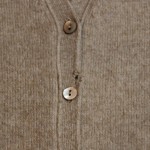This fall when I was taking my winter clothes down from the attic, one of my favorite cashmere cardigans I discovered had quite a few moth holes in it. I’d had it for a few years, and it was a little big on me since I’d lost some of the weight I’d been carrying around for a while, but it was still a nice cashmere sweater that was great for every day wear. Nobody would ever accuse me of being fashionable, but I do try and draw the line at walking around with moth holes in my sweaters.






Maybe because I’d recently finished making my Quilted Sweater Blanket, it occurred to me that I could cover those moth holes creatively and still get plenty of use from the sweater. I gathered up some of those felted sweater scraps I had and got to work. I decided to use varying sizes of circles, but you could use any shape you wanted. I used a small straight stitch on my sewing machine and went around each circle several times overlapping the stitched circles a bit just because I liked the way it looked. You could also use a small zig-zag stitch if you wanted. I covered the moth holes first, and then I added more circles around some of the first circles for decoration. I also thought doing this on some of them would keep it from looking like what it was (patches covering moth holes), and more like a fashion statement.




If you’re not me and don’t have boxes of felted sweaters hoarded in your basement for times like these, then go down to your local thrift store, or to your own closet, and get some sweaters that
a) don’t fit anymore
b) have moth holes in them and you don’t care to save the sweater
c) you accidentally washed it and ruined it (in this case the sweater is felted already and your job is done).
Throw the sweaters into the washing machine and then into the dryer. You may have to do this a few times, especially with cashmere or blended sweaters to get a good felted sweater. Once your sweater is felted, you can cut the material and you don’t have to worry about it unravelling on you. The felting process binds the fibers together. This process only works on natural fiber sweaters. Wool works the best, but you can use wool blends as long as the percentage of wool is pretty high. Pure cashmere felts too, but it usually takes a few washes in hot water to get it done right.




I finished this just before we went away for our Christmas break to Wyoming, and I wore that sweater a lot. I can tell you that I don’t think I ever got a compliment on that sweater before, but I got so many compliments on it after I’d done this to it I was shocked.


So don’t throw that sweater out! Get creative.
Creatively Repairing Moth Holes
Posted by on January 3, 2012 1 Comment
I have an inherited sweater that was hand knitted. It was the perfect shade of green. Not too light not too dark, not too yellow not too blue, and definitely not the color of slime or snot. I wanted to repair it. Just maybe to see if I could. A challenge. Plus I needed something for St Pattys day. A tradition. (See the last name?) I thank you for your post. I am going to try to save the sweater. I will likely send you an update. It is rainy and bleak, and a good day to sew.